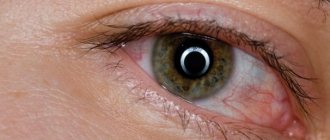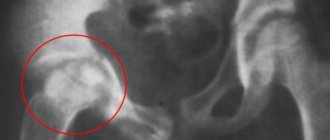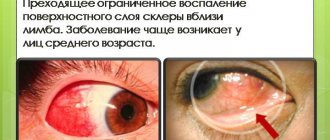Allergic conjunctivitis is an inflammation of the conjunctiva, which is caused by a reaction of the body systems to an allergen. The conjunctiva contains a huge number of cellular compounds of the immune system that release a chemical substance if various antigens interfere.
This substance is a mediator that causes inflammation of the eye membrane. The inflammatory process can be both short and long. 20% of people may have varying degrees of allergic conjunctivitis.
What it is?
Conjunctivitis is a group of diseases in which the mucous membrane of the eye becomes inflamed. It is provoked by various viruses, bacteria and allergens, and therefore there are different types of conjunctivitis. They have similar symptoms, but completely different approaches to treatment.
Atopic conjunctivitis is a type of allergic form, which is characterized by clear signs and develops when exposed to unfavorable external factors. For the development of the disease, a combination of several factors is necessary, and one of them is a hereditary predisposition.
Reference. Atopic conjunctivitis often accompanies other diseases, and also contributes to the addition of a secondary infection.
Causes
The basis of any atopic manifestation of the eyes is a predisposition to allergies, decreased immunity and external factors.
Increased sensitivity to certain substances - allergens - is caused by malfunctions of the immune system. They may be:
- plant pollen;
- animal hair;
- dust;
- cosmetics and household chemicals;
- prolonged or improper use of contact lenses;
- some medications (for external use).
A feature of atopic conjunctivitis is that it occurs when the allergen comes into direct contact with the mucous membrane of the eye, i.e. contact with the conjunctiva of any of the above substances.
Allergens that cause allergic conjunctivitis
We've already mentioned that pollen and tree fluff are just a couple of irritants that cause the symptoms of allergic conjunctivitis. The full list is much broader; it includes fungal spores, household chemicals, and animal hair or dander.
Drug allergies stand apart . The signs of the disease described above may appear after using certain medications, for example, eye drops, while using contact lenses, cosmetics or perfumes.
Such a wide list of allergens leads to the fact that the disease may not be seasonal, but year-round. In addition, this partly complicates diagnosis, since identifying a specific allergen can sometimes be quite difficult, and various detection methods are used for this.
Causes of allergic conjunctivitis
Most often, allergic conjunctivitis occurs due to the body encountering allergens: chemical, household, plant or animal, or medicinal. The most “problematic” substances are considered to be perfume and cosmetic products, household chemicals, house dust, bird feathers and fluff, and dry food for aquarium fish.
As a result of exposure to an allergen, histamine and other substances are released from mast cells, which leads to irritation of nerve endings, dilation of eye vessels and excessive lacrimation.
Sometimes the conjunctiva - the mucous membrane that covers the eyeball and the inner surface of the eyelid - can become inflamed after a foreign body gets into the eye or non-compliance with the rules for using contact lenses.
Classification
There are two forms of atopic conjunctivitis.
Acute form
Acute conjunctivitis appears suddenly, is characterized by severe symptoms and the formation of nodules on the mucous membrane of the eyelids and conjunctiva. As a rule, this disease occurs in children, as well as some adults, during the flowering period or during the poplar fluff season.
The acute form is usually seasonal and may occur only once or occur at the same time every year. The risk of developing this disease is higher in people with asthma or tuberculosis.
Symptoms of the disease, in addition to the typical symptoms of conjunctivitis, include:
- formation of yellow bubbles on the mucous membrane of the eye or cornea;
- photophobia.
Sometimes acute conjunctivitis goes away on its own.
Chronic
The chronic form does not have such pronounced symptoms, but the disease is more difficult to treat. In addition, in the initial stages there may be no signs at all, and later small rashes and thickening appear in the conjunctival area.
How does chronic allergic conjunctivitis manifest?
Symptoms of the disease can torment the patient for several years. During the period of exacerbation, the clinical picture of chronic conjunctivitis is similar to the manifestations of acute conjunctivitis.
- In addition to the cutting pain, a tingling sensation appears.
- The patient experiences a sensation of a foreign body in the eye.
- In bright light, the intensity of the unpleasant sensations increases.
- The rash on the conjunctiva is mild.
Damage to the limbus is not always observed. Chronic forms of the disease are difficult to treat. It is almost impossible to diagnose them. During the period of remission, the symptoms are mild, and the allergen cannot always be identified. Meanwhile, prescribing the correct treatment is possible only if the cause of the disease is discovered.
Chronic conjunctivitis can develop in both young and old people. Its occurrence is often associated with improper treatment of the acute form. Identification of the allergen is carried out using laboratory tests, which require a certain time.
Diagnosis is facilitated by the presence of other allergic reactions. Before prescribing etiotropic treatment, it is necessary to use eye drops that relieve unpleasant symptoms. Before use, the drug is heated to a comfortable temperature.
What is allergic conjunctivitis and when does it occur?
Many people are interested in the question of what allergic conjunctivitis is, why it occurs and how to deal with it. This disease is an inflammatory process triggered by an immune reaction in response to contact with an allergen and affecting the conjunctiva of the eyes. The following are allergic conjunctivitis:
- vernal keratoconjunctivitis. The disease damages the conjunctiva and cornea of the eyes. The disease manifests itself in children from 4 to 10 years of age, less often in adolescents. Most often it affects boys living in hot countries.
- seasonal conjunctivitis (hay fever). This causes damage to the upper respiratory tract and eyes. The disease can occur at any age and can occur in both men and women. The peak of the disease occurs in the spring and summer months, namely during the flowering period of plants;
- chronic allergic conjunctivitis. Develops in 23% of patients with conjunctivitis. The disease is persistent in nature and is often combined with bronchial asthma and eczema. The disease is most often detected in urban residents, mainly women;
- drug conjunctivitis. Most often it is a local reaction to the use of drugs for topical or systemic use;
- atopic keratoconjunctivitis. Systemic immunological reaction occurring against the background of atopic dermatitis, hay fever or asthma;
- large capillary conjunctivitis. The inflammatory process develops in response to prolonged contact with a foreign body. In this case, papillae up to 1 mm in size appear on the conjunctiva;
- infectious-allergic conjunctivitis. The cause of its development is a bacterial, viral or fungal infection. The disease is classified as a delayed type allergic reaction.
Allergic conjunctivitis in children
In children under three years of age, this disease is quite rare. This is quite common in older children. In addition to the eyes, the nasal mucosa is affected, which manifests itself in the form of allergic rhinitis.
Often the disease is diagnosed in children who have a history of other types of allergies (diathesis, allergic dermatitis and a number of others).
Treatment of the disease is not much different from the treatment of adult patients. First of all, any contact of the patient with the allergen is excluded. Then they begin to give the child antihistamines in combination with symptomatic treatment.
Quite often, children experience pseudoallergic reactions, when the symptoms are very similar to allergies, but their development is associated with completely different reasons. Therefore, diagnosis must be very thorough.
Symptoms
The disease begins with redness of the mucous membrane of the eyelids and conjunctiva, irritation and severe itching. Tear production and photosensitivity increase.
In the acute form of conjunctivitis, lymphoid cells and plasma elements form yellowish vesicles or nodules, which can be located on any part of the eye. Over time, they resolve and turn into small ulcers, which in some cases release an infiltrate. If a person has tuberculosis, the infiltrate will contain the tuberculosis bacillus.
The discharge leads to difficulty opening and closing the eyes. After waking up, the eyelids stick together, because during sleep the accumulated infiltrate turns into crusts.
Atopic conjunctivitis is often accompanied by a runny nose and difficulty breathing.
The chronic form is characterized by tingling and burning, a sensation of a foreign body in the eye and severe photophobia. Otherwise, the disease manifests itself in the same way as other forms of conjunctivitis.
Symptoms and complications
The disease occurs both in acute form (occurs unexpectedly, lasts a short period of time, passes quickly), and in chronic form (lasts a long period and has a less aggressive form).
The main signs of allergic conjunctivitis:
- pronounced redness of the whites of the eyes (see photo above);
- fear of sunlight;
- excessive and uncontrollable lacrimation;
- severe swelling of the eyes;
- burning sensation in the eyes;
- partial visual impairment;
- inflammation of the eyelids;
- general malaise, fatigue.
Allergic conjunctivitis in adults occurs in the same way as in children. However, in small allergy sufferers, the disease may be accompanied by allergic rhinitis caused by allergic reactions.
If the signs of the disease are minor and last more than six months, a chronic form of conjunctivitis is diagnosed. Usually, with this form, the patient is also worried about other diseases, for example, atopic dermatitis or bronchial asthma.
Conjunctivitis often becomes chronic, since its symptoms can be so subtle that it is not always possible to immediately detect and treat them in a timely manner.
In the acute form of this disease, the patient immediately becomes ill: the eyes become red and watery, there is severe itching and burning, and the face swells. If you do not provide timely medical attention to an allergy sufferer, severe swelling may occur, and subsequently threatens loss of vision.
If symptoms indicating the presence of allergic conjunctivitis occur, you should consult an ophthalmologist to determine an accurate diagnosis. If the allergic nature of the disease is confirmed, it is necessary to visit an allergist-immunologist to prescribe comprehensive treatment.
Complications
Without proper professional treatment, allergic eye disease can lead to complications such as:
- mechanical injury to the transparent membrane of the eye;
- the occurrence of a bacterial or viral infection;
- loss of clarity of vision;
- addition of other allergic reactions.
Diagnostics
When contacting a doctor, the patient needs to describe his condition in detail: tell whether he is allergic to anything, when the first symptoms appeared and what they were, as well as at what time they intensified.
Basic diagnostic methods at the first visit to the doctor:
- ophthalmological examination;
- taking a smear from the mucous membrane of the eye.
After this, a general blood test is prescribed, as well as an immunoglobulin E test. Special skin tests are performed to identify allergens.
Which doctor should I contact?
If you have signs of conjunctivitis, you should consult an ophthalmologist. The main task of the doctor is to determine the type of conjunctivitis, since it can be viral, bacterial, or allergic.
After the ophthalmologist has carried out his diagnosis, you may need to consult an allergist: it is this specialist who conducts allergy tests.
Symptoms of allergic conjunctivitis
Symptoms and treatment of allergic conjunctivitis may vary depending on the type of disease, but common, “signature” signs can be identified. Among them:
- Itching and burning;
- Redness of the conjunctiva;
- lacrimation;
- Mucus department;
- Swelling of the eyelids;
- Photophobia.
If you are concerned about one or more of the listed symptoms, we recommend that you consult an ophthalmologist who will prescribe the necessary medications for allergic conjunctivitis. Diagnosis of the disease is carried out on the basis of anamnesis, examination, clinical studies (general blood test, allergy tests), and visual acuity testing.
Treatment
After diagnosis, a treatment strategy is chosen, which always begins with eliminating the allergen. Next, a conservative therapy regimen is drawn up, consisting of drug treatment and the use of folk remedies.
What medications are used?
Medicines for this disease are aimed at relieving symptoms, strengthening the immune system and preventing re-inflammation.
Drops
Eye drops have a quick and good effect: just a few minutes after instillation, the symptoms of conjunctivitis become less noticeable, redness and swelling disappear, and inflammation is relieved.
For atopic conjunctivitis, antihistamine drops are prescribed. They act faster than tablets and additionally moisturize the conjunctiva. The most famous drops for conjunctivitis include Allergodil, Visin Allergy, Zaditen, Cromohexal, Opatanol.
For dryness and irritation of the mucous membrane, moisturizing drops can be additionally prescribed, for example, Systane or Visine “Pure Tear”.
In cases of severe disease, eye drops with corticosteroids are prescribed.
Ointments
Hormonal ointments are prescribed in advanced cases of atopic conjunctivitis or when an infection is attached. Eye ointments may contain either antibacterial or antiallergic components.
The most effective and frequently prescribed ointments:
- Maxidex (used for non-purulent forms of the disease);
- Tobradex (has antibacterial, antiallergic effects);
- Dexa-Gentamicin (combined action drug);
- Garazon (anti-inflammatory ointment);
- Cortineff (similar in principle to Garazon).
Allergic conjunctivitis and methods of its treatment
- Eye drops (usually these drops neutralize the allergen that gets into the eye, they are prescribed to you by your doctor).
- Tablet medications (blocking the action of certain inflammatory substances).
- Immunotherapy (used when the allergen is precisely known).
- Antibiotics and antiseptics (preventing the development of infectious complications).
- Hormonal medications (usually used in the most severe cases, the duration of treatment is also determined by the doctor)
Treatment with folk remedies is not recommended, since any interference with the eye by a foreign substance can cause side effects and blurred vision. If you value your eyes, you should not try to pour household products onto the eye shell.
Treatment with medications
How to treat the disease? Currently, in Russian pharmacies you can find several effective remedies for the treatment of allergic conjunctivitis.
These include the following drops and solutions :
- Allergodil . The product quickly eliminates the symptoms of inflammation and irritation and has virtually no side effects, so it is well tolerated by most patients. Sometimes, immediately after instillation, you may feel that the symptoms are only getting worse, but this feeling goes away after a few minutes, and the condition of the visual organs improves.
- Lecrolin. Antihistamine based on sodium cromoglycate. It is used as part of a therapeutic course of long-term use, therefore it is often prescribed for chronic forms of the disease. As a mild side effect, after instilling lecrolin, the patient may experience a slight burning and tingling sensation in the eyes, but this effect lasts no more than two minutes.
- Cromhexal . Ophthalmic drops with decongestant action, which eliminate most of the external symptoms of allergic conjunctivitis (including burning, redness and itching). This remedy is characterized by slow therapeutic effects, and the maximum positive effect of the remedy may be obvious only a few days after the start of instillations.
- Opatanol. Another drops for the treatment of allergic conjunctivitis over a long period of time. Already a few days after the start of the course of instillation, patients notice the disappearance of swelling, uncontrolled tearing stops, and redness disappears. The drug reaches its maximum concentration two hours after instillation. In case of overdose, as well as in case of intolerance to the drug, dizziness, drying of the mucous membranes, headaches, and increased symptoms of the disease may occur (dissipates with time).
Tablets and drops for allergic conjunctivitis
In the complex therapy of conjunctivitis, antiallergic drugs with different mechanisms of action are used.
| Group | Active ingredient and name | Action |
| Histamine (serotonin) receptor blockers |
| Drugs in this group block H1 and H2 histamine receptors. Reduce capillary permeability, eliminate itching. Diazolin, Diphenhydramine, Tavegil have a sedative and hypnotic effect. |
| Mast cell membrane stabilizers |
| Stabilizes mast cell membranes, has an antiallergic effect, reduces spasm of the bronchial muscles and capillary permeability. |
| Glucocorticosteroids |
| Has anti-allergic and anti-inflammatory effects, eliminates itching. |
First of all, eye drops are prescribed for allergic conjunctivitis. The doctor selects the drug, depending on the severity of the symptoms of the disease and the age of the patient.
Cromohexal
Cromohexal (Kromofarm, Lecrolin, Ifiral) contains sodium cromoglycate. It stabilizes mast cell membranes, thereby preventing the release of inflammatory mediators. The drug helps to quickly get rid of allergy symptoms. In acute forms of the disease, it is used up to 8 times a day, then 4 times a day.
Cromohexal is used for long-term treatment of allergic conjunctivitis. Therapy is continued until the person completely stops contact with the allergen. According to reviews from people who have used it, the drug is quite effective and safe. But quite often when using it, there is a feeling of a foreign body in the eyes and a burning sensation.
Ketotifen
Ketotifen eye drops for allergic conjunctivitis contain ketotifen fumarate. They have antiallergic and anti-edematous effects. Drops are used for the prevention and treatment of allergic conjunctivitis in adults and children. The drug is prescribed 1 drop twice a day.
According to patient reviews, when using Ketotifen in the form of eye drops, sometimes an adverse reaction occurs in the form of dry eyes or increased sensitivity to light. The advantage of the drug is its low cost and minimal number of contraindications.
Pharmadex
The medicine contains dexamethasone, boric acid and sodium tetraborate. These eye drops for allergic conjunctivitis have a pronounced anti-inflammatory and antiallergic effect. In the acute form of the disease, they are used every 2 hours, and subsequently prescribed 3-4 times a day. The treatment period can range from 2 to 9 days.
It is not recommended to use them in case of hypersensitivity to components, glaucoma, bacterial and fungal infections. Long-term use may cause increased intraocular pressure or thinning of the cornea.
According to reviews from patients who use Farmadex drops to treat chronic allergic conjunctivitis, the product is quite effective, quickly eliminates the manifestations of the disease and is inexpensive. But some people claim that after using it they have a headache and a feeling of dry eyes.
Flarex
The active ingredient in Flarex is fluorometholone. The drug belongs to the group of corticosteroids and is used to treat inflammation of non-infectious origin. Clinical studies show that, unlike Dexamethasone, Flarex has less of an effect on eye pressure.
For allergic conjunctivitis in adults, these drops are used 2-4 times a day. Drop 1-2 drops into the eyes. It is not recommended to use them for acute superficial keratitis, chickenpox or fungal eye infections.
When using the drug, side effects may develop in the form of decreased visual acuity or glaucoma with damage to the optic nerve. Also, during the treatment process, a secondary infection may occur.
Reviews from patients indicate that Flarex allows you to quickly cope with the manifestations of the disease and causes virtually no side effects. The disadvantages include the high cost of the drug. Drops can be bought both in Moscow and in other cities.
Sofradex
Sofradex is a combination drug that contains framycetin, gramitsedin (broad-spectrum antibiotics) and dexamethasone (glucocorticoid). The drug acts bactericidal, has a pronounced anti-inflammatory effect, antiallergic and antipruritic effect.
When applied topically, it copes well with itching, eliminates redness of the eyes, reduces lacrimation, eliminates burning sensation and photophobia. Children and adults are prescribed 1-2 drops of the product up to 6 times a day. Treatment is continued for no more than 7 days, since with prolonged use there is a risk of increased eye pressure.
It is not recommended to use Sofradex for viral and fungal conjunctivitis, tuberculosis, glaucoma or hypersensitivity to components.
According to reviews of people who have cured allergic conjunctivitis with Sofradex, this is a fairly effective and reliable remedy that quickly eliminates the signs of the disease. Some patients attribute its high cost to its disadvantages.
Hydrocortisone ointment
Hydrocortisone has antiallergic and anti-inflammatory effects. It stabilizes cell membranes and reduces the severity of the immune response. Hydrocortisone eye ointment is injected into the conjunctival sac 2-3 times a day for 7-14 days.
It is not recommended to use it for viral, fungal or bacterial diseases, or if the integrity of the eye membranes is compromised. According to reviews from people who have used the ointment, the product is very effective and helps to quickly get rid of allergy symptoms.
Prevention
Considering the risk factors for developing the disease, its main preventive measures are strengthening the immune system, vitamin supplementation and avoiding contact with a potential allergen. If a person has weakened body defenses, he has a tendency to allergies, preventive measures include:
- regular ventilation of the room;
- timely wet cleaning of the apartment;
- wearing sunglasses during the flowering period;
- eating foods rich in vitamins and microelements necessary for eye health.
Walking in the fresh air also has a positive effect on the condition of the eyes, since access to oxygen improves metabolic processes in the structures of the eye apparatus.
If you experience repeated allergic reactions, you should contact an allergist and ask to prescribe antihistamines, which should always be in your medicine cabinet. However, you cannot prescribe certain medications yourself.
Useful video
Chronic conjunctivitis, interaction between doctor and patient:
Therapy and traditional methods of treatment
Treatment can be divided into three stages.
- Identification and elimination of the root cause - allergen - irritant.
- Medications that can enhance immune defense.
- Elimination of the underlying disease, mainly with antibiotics.
In mild or initial stages, antibiotics are not used. Therapy is based on raising the immune system and stimulating it to fight irritants. Eye drops or ointments are used to eliminate inflammation and alleviate negative sensations. Immunotherapeutic drugs are prescribed, such as histaglobulin, which in a course of eight injections can significantly increase the level of the body's protective functions.
The use of any antibiotics is permitted only after consultation with a doctor.
If an allergen is identified, or antibiotics do not have the desired effect, then it is possible to use the allergens themselves to treat them. And in severe cases of the disease, antihistamines are used. But when using them, the use of albucid and other medications that are not prescribed by a doctor is prohibited.
Antiallergic therapy is prescribed in any case, regardless of the type of allergen. Its main task is to relieve the main symptoms that bother the patient. Basically, these are ointments and drops. Their action is not aimed at treating or improving the patient’s condition, but at eliminating unpleasant sensations. The use of such a medicine is permissible only with the permission of a doctor, otherwise an overdose may cause even greater irritation to the eyes.
Traditional medicine is effective in the early stages of the disease, as a substitute for drops against inflammatory processes and relieving swelling. The prepared homemade analogue is in no way inferior in effectiveness to the medicine.
Method No. 1
One glass of millet is poured into two glasses of cold water and steamed over the fire for twenty minutes. Then it is infused with the lid closed for up to three hours. The finished infusion is used to wipe off growths, discharge and relieve swelling.
Method No. 2
One tablespoon of agrimony herb is poured into half a liter of boiling water and infused in a thermos for an hour. Prepared tampons are moistened in the broth and applied to the eyes for twenty minutes three times a day.
This method dissolves nodules very well and relieves inflammation.
Method No. 3
Add two tablespoons of calendula to the partitions of ten walnuts and pour two cups of boiling water. Leave for at least five hours in a warm, dark place. Strain, moisten the swabs and apply to the eyes for half an hour. You need to do this five times a day. With daily use, the inflammation goes away quickly.
Of course, folk recipes do not cure the disease itself, but they are in no way inferior to medications in eliminating symptoms and relieving inflammation.










